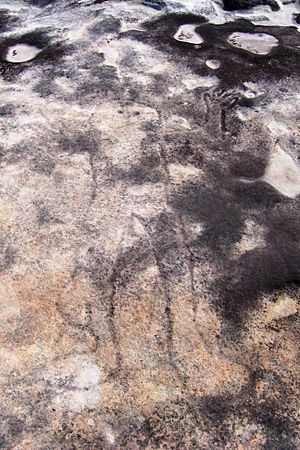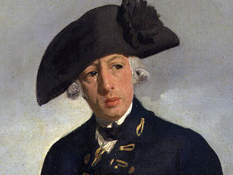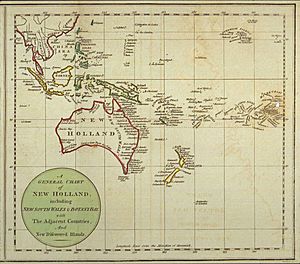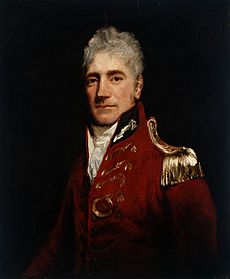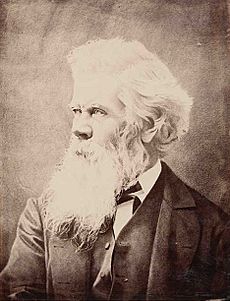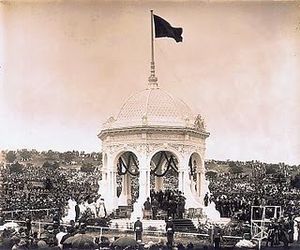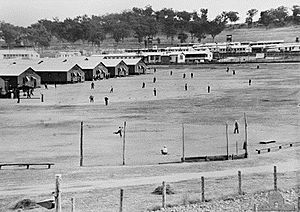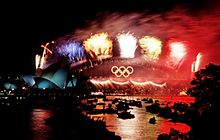History of New South Wales facts for kids
The history of New South Wales tells the story of Australia's oldest state, New South Wales. It covers the time when Indigenous Australians first lived there, and then when the British arrived and set up a colony. People have lived in parts of New South Wales for at least 40,000 years, as shown by the Lake Mungo remains.
In 1770, the English explorer James Cook was the first European to map the coast. Then, in 1788, a group of British ships called the First Fleet arrived. They brought convicts to start a new settlement in Sydney.
New South Wales began to govern itself with a Parliamentary democracy in the 1850s. In 1901, it became a state within the country of Australia. Throughout the 20th century, many different people from all over the world came to live in New South Wales. Today, it is the most populated state in Australia. Its capital, Sydney, is a major financial city and hosts many big international events.
Contents
Ancient History of New South Wales
The very first people to live in the area we now call New South Wales were Aboriginal people. They arrived in Australia about 40,000 to 60,000 years ago. Their ancestors came by boat from what is now Indonesia. These early people moved south and lived all over Australia, including the future New South Wales.
Evidence like the Mungo Man has been found at Lake Mungo in New South Wales. These remains are about 40,000 years old. They show that early humans were buried with special ceremonies. Stone tools and bones of huge, now-extinct animals like giant kangaroos were found nearby. These findings suggest that New South Wales was populated long before the British arrived. The climate was much wetter then, and people were already creating art and religious practices. You can still find examples of Aboriginal stone tools and Aboriginal art in New South Wales today. Some are even in modern Sydney, like in Ku-ring-gai Chase National Park.
European Arrival and Settlement
James Cook's 1770 Proclamation
In 1770, Lieutenant James Cook sailed along Australia's east coast on his ship, the HMS Endeavour. He was the first known European to do this. On April 19, 1770, his crew saw the east coast. Ten days later, they landed at a bay in what is now southern Sydney. The ship's scientist, Sir Joseph Banks, was amazed by all the new plants and animals. Cook named the bay Botany Bay.
Cook mapped the entire east coast. On August 22, at Possession Island, he claimed the whole eastern coast for King George the Third. He named this land "New South Wales." Cook and Banks then told London that Botany Bay would be a good place for a British colony.
This made the Kingdom of Great Britain the first European power to officially claim land on the Australian mainland. Cook's "New South Wales" covered most of eastern Australia. It stretched from near modern Mordialloc, Victoria up to Cape York. It did not include Tasmania (claimed by the Dutch) or the west coast (claimed by the French).
Establishing the Colony in 1788
The British claim became real in January 1788. Arthur Phillip arrived with the First Fleet to start a convict settlement near what is now Sydney. Phillip became the first Governor of New South Wales. He had authority over a huge area, including most of Australia east of the 135th meridian east and even parts of New Zealand.
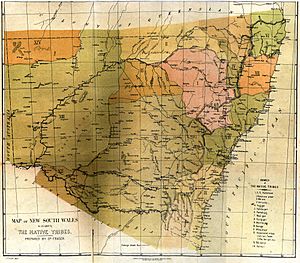
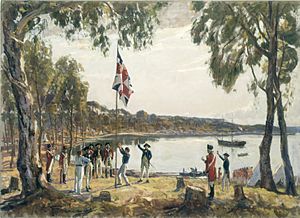
The First Fleet had 11 ships and over a thousand settlers. This included 778 convicts. After a few days at Botany Bay, the fleet moved to Port Jackson. Phillip set up the settlement at Sydney Cove on January 26, 1788. This date is now Australia Day. Sydney Cove had fresh water and a safe harbor. Phillip famously called it "the finest Harbour in the World."
Governor Phillip had full power over the colony's people. He wanted to have good relations with the local Aboriginal people. He also aimed to help and discipline the convicts. The first few years were very hard. Food and supplies were scarce. Many convicts were sick or not fit for work. Between 1788 and 1792, about 3,546 male and 766 female convicts arrived. Many were "professional criminals" with few skills needed for building a colony.
The food situation became critical in 1790. The Second Fleet arrived in June 1790, but a quarter of its passengers had died from sickness. From 1791, more ships arrived regularly, and trade began. This helped with supplies and made the colony feel less isolated.
Phillip sent groups to explore for better farming land. They found the Parramatta region promising. Many convicts moved there from late 1788 to start a small town. Parramatta became the main economic center, while Sydney Cove remained an important port. Farming was difficult due to poor tools and unfamiliar land. However, building work, helped by convict labor, moved forward.
By 1792, the population included more and more freed convicts. These "emancipists" could be given land. They started a private economy. Soldiers whose service ended and free settlers from Britain also joined them. Governor Phillip left the colony in December 1792. The new settlement had survived four years of near starvation and great isolation.
For the next 40 years, the history of New South Wales was much like the history of Australia. Other settlements, like those in Tasmania, were part of New South Wales at first. Tasmania became a separate colony in 1825. In the same year, New South Wales's border moved west to the 129th meridian east. In 1829, this became the border with Western Australia, which became its own colony.
The Indigenous Australians had lived in New South Wales for at least 50,000 years. They lived by hunting, gathering, and fishing. European settlement had a terrible impact on them. They had no protection against European diseases like measles and smallpox. These diseases spread quickly, reducing their population and disrupting their society. There was some resistance, but generally, Aboriginal people were forced off their lands.
Watkin Tench, an officer on the First Fleet, wrote about early meetings between Sydney's Aboriginal people and the British. The colony struggled to support itself at first. The whaling industry brought some early money. But it was the wool industry, started by John Macarthur and his wife Elizabeth Macarthur, that became the colony's first big export. For the first half of the 19th century, New South Wales was mainly a sheep farming area. Sydney was the main port, with smaller towns like Newcastle (established 1804) and Bathurst (1815).
Newcastle, north of Sydney, was first a strict punishment camp for convicts. It grew into a major industrial city. Wollongong, south of Sydney, started in 1829. It was a military outpost due to conflicts between Aboriginal people and timber-getters. Farming, dairy, and coal mining soon developed there. The Hawkesbury and Nepean Wars (1795–1816) were conflicts between the British and local Aboriginal groups.
New South Wales began as a colony ruled by the Governor. The Governor usually followed British law. Early Governors ruled with advice from military officers and leading settlers. The New South Wales Corps was a military regiment formed in 1789. Its officers became involved in an illegal trade of rum. In the Rum Rebellion of 1808, the Corps, with John Macarthur, took over the government. They removed Governor William Bligh. This led to a short period of military rule before Governor Lachlan Macquarie arrived in 1810.
Macquarie was the last Governor with absolute power, serving from 1810 to 1821. He played a big role in New South Wales's growth. He helped it change from a penal colony to a developing free society. He started public works, a bank, churches, and charities. He also tried to have good relations with Aboriginal people. In 1813, he sent Gregory Blaxland, William Wentworth, and Lawson to cross the Blue Mountains. They found large plains in the interior.
Macquarie believed that freed convicts, called "emancipists," should be treated equally to free settlers. Despite opposition, he appointed emancipists to important government jobs. For example, Francis Greenway became the colonial architect. London thought his public works were too expensive, and society was shocked by his treatment of emancipists. His legacy lives on with Macquarie Street, Sydney and the Parliament of New South Wales bearing his name.
By 1821, there were only 36,000 Europeans in the colony. After the Napoleonic Wars ended in 1815, more free settlers arrived. By the 1820s, free settlers began to occupy most of what is now rural New South Wales. A settlement was started at Bathurst, west of the Blue Mountains, in 1815. Farms there began to raise cattle, grow crops, and produce fine wool for Britain. The period from 1820 to 1850 is known as the "golden age of the squatters" (people who settled on land without legal ownership).
In 1825, the New South Wales Legislative Council was formed. It was Australia's oldest law-making body, appointed to advise the Governor. Also in 1825, trial by jury was introduced, ending the military's power in courts. In 1842, the Council became partly elected. This was possible because convict transportation to New South Wales ended in 1840. By then, 150,000 convicts had been sent to Australia. After 1840, settlers saw themselves as free people and demanded the same rights as in Britain. New Zealand, which was part of New South Wales, became a separate colony in 1841.
Developing the Colony
Exploring New Lands
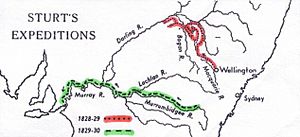
In 1795, George Bass and Matthew Flinders explored the Georges River near Sydney. Their reports led to the settlement of Bankstown. In 1796, they explored further south to Lake Illawarra and discovered Port Hacking. In 1798-99, Bass and Flinders sailed around Tasmania, proving it was an island.
Aboriginal guides often helped European explorers. In 1801-02, Matthew Flinders led the first trip around Australia. On his ship was Bungaree, an Aboriginal explorer from Sydney. He was the first person born on the Australian continent to sail around it. Before this, Bennelong and a friend were the first people from New South Wales to sail to Europe. They went with Governor Phillip to England in 1792 and met King George III.
In 1813, Gregory Blaxland, William Lawson, and William Wentworth crossed the Blue Mountains. They followed the ridges instead of the valleys. At Mount Blaxland, they saw vast grasslands. This opened up the interior for British settlement.
In 1824, Governor Thomas Brisbane asked Hamilton Hume and Captain William Hovell to find new grazing land in the south. They also wanted to find out where New South Wales's western rivers flowed. In 1824-25, Hume and Hovell traveled to Port Phillip and back. They discovered the Murray River (which they named the Hume) and many good farming lands.
Charles Sturt explored the Macquarie River in 1828 and found the Darling River. People thought the inland rivers might flow into an inland sea. In 1829, Sturt followed the Murrumbidgee River into a "broad and noble river," the Murray River. He named it after Sir George Murray. His group followed the river to where it met the Darling River. They continued to Lake Alexandrina, where the Murray meets the sea in what is now South Australia. The party had to row hundreds of kilometers back upstream.
Surveyor General Sir Thomas Mitchell led expeditions from the 1830s to map the remaining areas. He carefully recorded original Aboriginal place names. That's why many places today still have their Aboriginal names. In 1836, the new colony of South Australia was created and separated from New South Wales.
The Polish scientist and explorer Count Paul Edmund Strzelecki surveyed the Australian Alps in 1839. He was the first European to climb Australia's highest peak, which he named Mount Kosciuszko after a Polish hero.
The Gold Rush Era
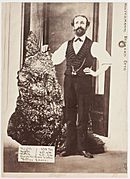
A new "golden age" began in 1851. Edward Hargraves announced the discovery of gold at Ophir near Bathurst. In 1851, New South Wales had about 200,000 people. The gold rushes of the 1850s brought many new settlers. Most went to the richest gold fields in the Port Phillip District, which became the colony of Victoria in 1851.
Hill End, near Bathurst, was a town that grew and then faded with the gold rush. It was famous for the "Holtermann Specimen," found in 1872. This was the largest single mass of gold ever discovered in the world. It weighed 630 pounds (286 kg) and produced about 205 pounds (93 kg) of pure gold.
Victoria soon had more people than New South Wales, and Melbourne grew larger than Sydney. But New South Wales's gold fields also attracted many prospectors. By 1857, the colony had over 300,000 people. Inland towns like Bathurst, Goulburn, Orange, and Young grew quickly. Gold brought wealth but also new social tensions. Many different groups of migrants came to New South Wales for the first time. Young was the site of an anti-Chinese miner riot in 1861.
The arrival of migrants also brought new ideas. Norwegians introduced Skiing in Australia to the hills above Kiandra around 1861. A famous Australian writer, Henry Lawson, was born to a Norwegian miner in 1867 at the Grenfell goldfields.
In 1858, a new gold rush in the north led to the separation of Queensland as a new colony in 1859. New South Wales then got its current borders. The Northern Territory remained part of New South Wales until 1863, when it was given to South Australia.
The separation and growth of Victoria and Queensland marked the true beginning of New South Wales as a distinct entity. There was strong competition between New South Wales and Victoria. New South Wales remained more focused on trade and exports, supporting free trade. Victoria focused more on manufacturing and had high taxes on imported goods.
At Broken Hill in the 1880s, BHP Billiton (now a big global mining company) started as a silver, lead, and zinc mine. By 1891, Broken Hill had over 21,000 people, making it the third-largest town in New South Wales.
Cultural Growth and Institutions
During the 19th century, New South Wales built many important cultural institutions. The first Sydney Royal Easter Show, an agricultural exhibition, started in 1823. Alexander Macleay began collecting items for Sydney's Australian Museum in 1826. The current museum building opened in 1857. The Sydney Morning Herald newspaper began printing in 1831. The University of Sydney opened in 1850. The Royal National Park, south of Sydney, opened in 1879.
The New South Wales Rugby Union was formed in 1874. The first club competition took place in Sydney that year. In 1882, the first New South Wales team played against Queensland. In 1878, the first major cricket match at the Sydney Cricket Ground was played between New South Wales and Victoria.
The Sydney International Exhibition of 1879 showed the world what the colonial capital could do. Some exhibits from this event became the first collection of the new Technological, Industrial and Sanitary Museum of New South Wales (now the Powerhouse Museum).
Two Sydney journalists, J.F. Archibald and John Haynes, started The Bulletin magazine in 1880. It was a journal of politics and business, with some literature. It became very influential and helped Australian writers and cartoonists like Henry Lawson and Banjo Paterson get published. A famous debate about life in the Australian bush happened in the magazine. This helped shape ideas about an Australian "national character."
Self-Government and Democracy
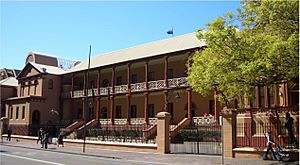
William Wentworth started the Australian Patriotic Association in 1835. This was Australia's first political party. It demanded democratic government for New South Wales. The reformist attorney general, John Plunkett, worked to create equality before the law. He gave jury rights to freed convicts and legal protections to convicts and Aboriginal people. Plunkett charged the colonists responsible for the Myall Creek massacre of Aboriginal people with murder. His important Church Act of 1836 made all major Christian churches equal under the law.
In 1838, Caroline Chisholm arrived in Sydney. She worked to help poor women migrants. She met immigrant ships, found jobs for girls, and set up a home for female immigrants. She also campaigned for legal changes to help reduce poverty and support female immigration.
The Sydney City Council was created in 1840. Men who owned property worth at least £1000 could run for election. Wealthy landowners could have up to four votes. Australia's first parliamentary elections were held for the New South Wales Legislative Council in 1843. Only males who owned property or had enough money could vote. The Australian Colonies Government Act in 1850 was a big step. It gave New South Wales, Victoria, South Australia, and Tasmania the right to create their own parliaments. These parliaments were democratic, but still had the British monarch as the symbolic head of state.
When convict transportation ended and the population grew after the gold rush, people demanded "British institutions." This meant an elected parliament and self-government. In 1851, more people could vote for the Legislative Council. But settlers, many of whom had been Chartists (people who wanted more rights for common people) in Britain, wanted more. Governors warned London that people might want a republic if self-government wasn't granted.
There was a long fight between conservatives, led by Wentworth, and democrats about the new constitution. A key issue was control of the pastoral lands. Democrats wanted to take land from the squatters and divide it into farms for settlers. Wentworth wanted a special upper house controlled by squatters to prevent this. Radicals, like Henry Parkes, made fun of the idea of a "bunyip aristocracy" (a fake noble class).
In 1855, South Australia gave all British males aged 21 or over the right to vote. This right was given to Victoria in 1857 and New South Wales in 1858.
The New South Wales Constitution Act of 1855 created a two-house Parliament of New South Wales. The lower house, the New South Wales Legislative Assembly, had 54 members elected by adult males who met a property requirement. The upper house, the New South Wales Legislative Council, had at least 21 members appointed for life by the Governor.
These rules seemed to limit democracy, but they didn't for long. The Constitution Act could be changed easily. In 1858, the property requirement for voting in the Assembly was removed, and the secret ballot was introduced. It was soon decided that the Governor should always follow the advice of his ministers. If the Council rejected a bill, the Premier could simply ask the Governor to appoint more members until the opposition was outnumbered. The government of Charles Cowper showed the victory of colonial liberalism. The main goal for liberals was to open up land from the squatters. This was largely achieved by John Robertson, who was Premier five times in the 1860s. He passed the Robertson Land Acts to break up large squatter estates.
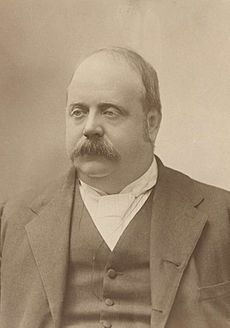
From the 1860s, government in New South Wales became more stable. Fears of class conflict lessened as the population from the gold rushes found homes on new farmlands and in growing towns. The last British troops left in 1870. Law and order were kept by police and a local militia.
Education was a big political issue. Catholics, Protestants, and secularists (those who wanted non-religious schools) argued about how schools should be run and funded. Henry Parkes, a dominant politician of the time, was Premier five times between 1872 and 1889. In 1866, as Education Minister, Parkes introduced a Schools Act that put all religious schools under public supervision, with state money. But in 1880, Parkes removed all state aid for church schools and created a statewide system of free, non-religious schools.
New South Wales and Victoria continued to develop differently. Parkes and his successor, George Reid, supported free trade. They saw it as good for the economy and for the British Empire. They thought Victoria's protectionism was foolish. This rivalry between the two largest colonies prevented them from uniting, even with railways and telegraphs making travel easier by the 1870s. As long as Victoria was larger and richer, New South Wales would not give up its free trade principles to a national government that Victorians would control.
At Broken Hill in the 1880s, BHP Billiton began as a silver, lead, and zinc mine. By 1891, Broken Hill was the third largest town in the colony.
Statehood and Modern Era
Joining the Australian Federation
By the 1890s, several things pushed the Australian colonies towards uniting. A long economic downturn in Victoria allowed New South Wales to regain its economic lead. There was also a growing feeling of loyalty to the British Empire. Other colonial powers like France and Germany in the Pacific made defense an urgent issue. The rise of Japan as a powerful nation also added to this concern. Finally, the issue of Chinese and other non-European immigration made federation important. People wanted a national immigration policy, leading to the idea of a White Australia policy.
The movement for federation was started by Parkes with his Tenterfield Oration in 1889. After Parkes' death, Edmund Barton continued the work. Opinion in New South Wales about federation was divided in the 1890s. Border regions, which were affected by colonial borders and tariffs, strongly supported it. Many in Sydney's business community were unsure, fearing a national parliament would impose national tariffs. The first attempt at federation in 1891 failed due to an economic crisis. Federalists from the border regions revived the movement in the late 1890s. This led to the Constitutional Convention of 1897-98, which created a draft Australian Constitution.
When the draft was put to a referendum in New South Wales in 1899, Premier Reid was undecided, earning him the nickname "Yes-No Reid." The draft was rejected. New South Wales voters thought the proposed Australian Senate, which smaller states would control, had too much power. Reid was able to negotiate with other Premiers to change the draft to suit New South Wales. The revised draft was then approved. On January 1, 1901, Queen Victoria proclaimed the Commonwealth of Australia. New South Wales stopped being a self-governing colony and became a state. The first Governor-General and Prime Minister were sworn in Sydney. Melbourne was the temporary capital, but the permanent capital had to be in New South Wales, at least 160 km from Sydney. The first Prime Minister (Barton), Opposition Leader (Reid), and Labor leader (Chris Watson) were all from New South Wales.
From Federation to World War II
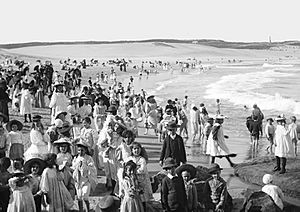
At the time of federation, New South Wales's economy relied heavily on agriculture, especially wool. Mining (coal from the Hunter Region and silver, lead, and zinc from Broken Hill) was also important. After federation, protective tariffs were put in place, which helped local manufacturing grow. Farmers, however, faced higher costs and a long drought.
World War I increased demand for goods, boosting manufacturing and farming. By the 1920s, New South Wales was becoming Australia's center for heavy industry. This was shown by the Broken Hill Proprietary (BHP) steelworks in Newcastle (opened 1915) and another steel mill in Port Kembla (1928).
The growth of industry led to a larger working class. Trade unions had formed in New South Wales in the 1850s. Major labor struggles in the 1890s pushed them into politics. The Australian Workers' Union (AWU) was important in forming the Labor Party. Labor had its first big success in 1891, winning 35 seats in the Legislative Assembly. After federation, Labor, led by James McGowen, soon recovered. They won their first majority in the Assembly in 1910, and McGowen became the state's first Labor Premier.
New South Wales Labor was more moderate than Labor parties in other states. This helped them win elections more often. The growth of coal, iron, steel, and shipbuilding industries gave Labor strong support in Newcastle and Wollongong. Mining towns like Broken Hill and the Hunter region also became Labor strongholds. As a result, Labor has governed New South Wales for many years since 1910.
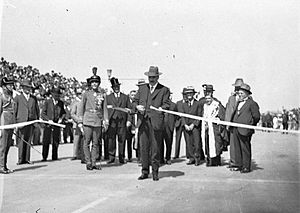
However, Labor faced problems during World War I. Premier William Holman supported Prime Minister Billy Hughes in trying to introduce conscription (forced military service). New South Wales voters rejected conscription twice. In 1916, Hughes, Holman, and many other Labor founders were expelled from the party. Federal Labor struggled for years, but New South Wales Labor was back in power by 1920, and again from 1925 under Jack Lang.
After World War I, farmers were very unhappy. Prices for their goods fell after the war. In 1919, farmers formed the Country Party. This party used its strong support to demand subsidies and public works for rural areas from non-Labor governments.
The Great Depression, starting in 1929, brought hard times to New South Wales. Many people lost jobs, and prices for goods collapsed. Lang's second government was elected in 1930. He wanted to stop paying New South Wales's debt to British lenders and use the money to help the unemployed. This was seen as illegal by conservatives and criticized by the federal Labor government. In May 1932, the Governor, Sir Philip Game, dismissed Lang's government. Labor was in opposition for the rest of the 1930s.
In 1930, at the Sydney Cricket Ground, Don Bradman, a young New South Welshman, scored 452 runs in a cricket match. This was a world record for first-class cricket. Bradman's amazing performances brought joy to Australians during the difficult Great Depression.
The 1938 British Empire Games were held in Sydney in February 1938. This was to celebrate 150 years since British settlement in Australia.
World War II and Its Impact
By the start of World War II in 1939, the differences between New South Wales and other states had lessened. World War II led to a big increase in industrial development to support the war effort. Unemployment also ended. When Ben Chifley, a railwayman from Bathurst, became Prime Minister in 1945, New South Wales Labor felt it had achieved national leadership.
During the Pacific War, the Imperial Japanese Navy attacked New South Wales waters. In May and June 1942, Japanese submarines attacked Sydney and Newcastle. Although there were few casualties, people feared a Japanese invasion. The main Japanese naval advance was stopped by the United States Navy in May 1942 at the Battle of the Coral Sea. The Cowra Breakout in 1944 saw Japanese prisoners of war try to escape from their camp in central New South Wales. This was the only fighting within New South Wales during the war.
New South Wales After World War II
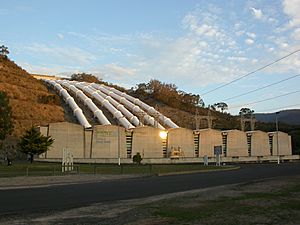
After the war, there were more industrial conflicts, including the 1949 Australian coal strike. This strike, partly caused by the Communist Party of Australia, hurt the state's industry. It contributed to the defeat of the Chifley government in the 1949 elections. This began the long rule of Robert Menzies and the new Liberal Party of Australia.
The postwar years also saw huge immigration to Australia. This was started by Chifley's Immigration Minister, Arthur Calwell, and continued by the Liberals. Sydney, which was mostly British and Irish, became much more multicultural. Many immigrants came from Italy, Greece, Malta, eastern Europe (including many Jews), and later from Lebanon and Vietnam. This permanently changed the city.
The Snowy Mountains Scheme began construction in the state's south. This huge project built sixteen major dams and seven power stations between 1949 and 1974. It was the largest engineering project in Australia. It needed 100,000 workers from over 30 countries. This project helped Australia become a "melting pot" of cultures. It also led to the creation of new towns like Cabramurra, Australia's highest town. Small rural towns like Adaminaby and Jindabyne had to move for the construction of Lakes Eucumbene and Jindabyne. Better access to the mountains led to the building of ski resorts like Thredbo and Guthega in the 1950s.
Labor stayed in power in New South Wales until 1965, when the Liberal Party, led by Robert Askin, won the government.
New South Wales Since the 1970s
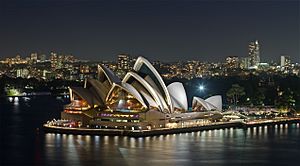
Since the 1970s, New South Wales has changed rapidly. Old industries like steel and shipbuilding have mostly disappeared. Agriculture is still important, but it makes up a smaller part of the state's income. New industries like information technology, education, financial services, and the arts have grown. These are mostly in Sydney. Coal exports to China are increasingly important. Tourism has also become very important, centered in Sydney but also growing on the North Coast around Coffs Harbour and Byron Bay.
As air travel replaced shipping, most new migrants to Australia now arrive in Sydney. Many come from Asia, Latin America, and the Middle East.
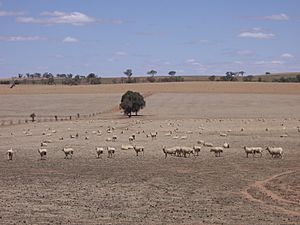
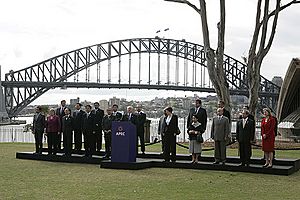
New South Wales has faced several natural disasters. In 1989, an earthquake struck Newcastle. It killed 13 people and injured over 160. The damage cost about A$4 billion. In 1990, major flooding hit the central west, with Nyngan suffering severe damage. In 1993-94, the state had a serious bushfire season, even affecting parts of Sydney. Farming was hurt by a long drought in the late 1990s and early 2000s, especially in the Murray-Darling Basin. The drought was followed by severe flooding in 2010.
In 1973, the Sydney Opera House officially opened. It was designed by Jørn Utzon. It became a symbol of Sydney and Australia. UNESCO listed it as a World Heritage site in 2007. Sydney has become very influential in Australia and worldwide. The city hosted the 2000 Summer Olympics, the 2003 Rugby World Cup, and the APEC Leaders conference of 2007. From 1991 to 2007, Sydney-siders were Prime Ministers of Australia: Paul Keating (1991–1996) and John Howard (1996–2007).
Sydney has also become more socially liberal. It has large entertainment and gambling industries. While Christianity has declined, Sydney's Archbishops remain active in national debates. The World Youth Day 2008, led by Pope Benedict XVI, brought huge crowds to the city. The Sydney Gay and Lesbian Mardi Gras has become world-famous. Star City Casino opened in the mid-1990s as Sydney's only legal casino.
The Australian Labor Party has governed New South Wales for long periods. They held power under Neville Wran and Barrie Unsworth from 1976 to 1988. The Liberal-National Coalition then ruled under Nick Greiner and John Fahey from 1988 to 1995. Labor, led by Bob Carr, returned to power in 1995 and stayed in office until 2011. Carr retired and was followed by other Labor premiers: Morris Iemma, Nathan Rees, and Kristina Keneally. Two recent Premiers, Greiner (Hungarian background) and Iemma (Italian parents), were of non-British descent. The current Governor of New South Wales, Marie Bashir, is of Lebanese origin and is the first woman to hold the office.
Experts predict that Sydney and the northern coastal areas of New South Wales will continue to grow. However, some, like Bob Carr, argue that Sydney (with over 4 million people by 2006) cannot grow much bigger without harming its environment and infrastructure. The southern coastal areas around Canberra are also expected to grow. But the rest of the state is expected to continue to decline as traditional industries disappear. Many small towns in western New South Wales have lost services and businesses, causing people to move to larger regional centers like Dubbo and Wagga Wagga.
Recent Political Changes
On March 26, 2011, the Liberal/National Coalition, led by Barry O'Farrell, won a big victory over the Labor Party. Many political experts saw this as a major shift in New South Wales politics, moving away from Labor being the usual party in power.
Defining New South Wales's Borders
It's interesting to note that New South Wales was only officially named and had its borders declared in 2001. This was 231 years after James Cook first used the name in 1770. The reason for this relates to how Australia's territories developed. After James Cook, the colony of New South Wales was established and named by Arthur Phillip in 1788. At that time, New South Wales covered about half of the Australian continent. Its size increased to about two-thirds of the continent in 1828.
All the other Australian states and two territories (except Western Australia) were later created from New South Wales during the 1800s and early 1900s. Each new state and territory was created by Britain. As new states were formed, New South Wales gradually shrunk. During this time, the exact boundary of New South Wales was never officially defined.
The remaining borders of New South Wales were finally and officially defined in the New South Wales government gazette on August 24, 2001. This means that even though New South Wales was the original state, its borders are defined by its boundaries with the other states that were created from it. The gazette states:
The Geographical Names Board has named New South Wales as the land bounded on the north by Queensland, on the west by South Australia, on the south by Victoria, and on the east by the Pacific Ocean coastline. This includes all lands controlled by the New South Wales Government, but not the Australian Capital Territory.
Images for kids
-
A chart of part of the interior of New South Wales by John Oxley, Surveyor General, 1822


